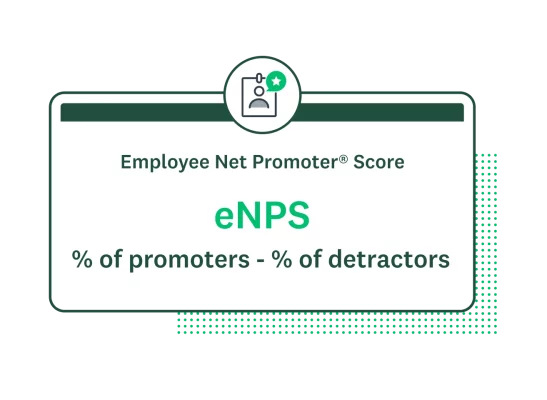20 questions to ask in an eNPS survey

Summary:
- The core eNPS question asks how likely employees are to recommend their workplace to others, categorizing them into Promoters, Passives, and Detractors.
- Follow-up questions should dig into drivers of engagement, such as satisfaction with management, clarity of goals, and work-life balance.
- Open-ended questions allow employees to provide context for their scores, revealing specific cultural or operational issues.
Employee engagement is a crucial factor for organizational success. When employees are engaged, they are more likely to commit to their work and invest in the company’s goals and mission, leading to higher job satisfaction and reduced employee turnover.
One effective way to track and analyze employee engagement is using employee Net Promoter Score (eNPS®) surveys. These surveys offer actionable insights into employee satisfaction, workplace culture, and experience.
What is eNPS?
eNPS is a metric that measures how your employees feel about working for your company. It’s based on the Net Promoter Score (NPS®), a common customer experience (CX) metric used to measure customer loyalty.
An eNPS survey starts with a primary question: "On a scale of 0 to 10, how likely are you to recommend our company as a great place to work?" Based on their scores, participants are categorized as promoters (if they rate the company a 9 or 10), passives (7 or 8), or detractors (0-6).
To calculate your eNPS, subtract the percentage of employees who are detractors from the percentage of promoters. Scores can range from -100 to 100. A high score indicates that your employees have a good relationship with your company and are more likely to refer it to others.

The 20 best eNPS survey questions to ask
All eNPS surveys must include the main eNPS question ("On a scale of 0 to 10, how likely are you to recommend our organization as a place to work?"). You’ll need this question to calculate your score.
However, you can and should add open-ended or qualitative questions to your eNPS survey. These follow-up questions can provide necessary context to the responses you receive to the main eNPS question. Try these questions to generate comprehensive feedback that reflects the employee experience:
1. What is the primary reason for your score?
2. How can we improve your experience at [company]?
3. What do you like most about working for [company]?
4. Do you feel valued and heard at [company]?
5. Are you satisfied with your work-life balance?
6. Do you feel you have enough training and development opportunities?
7. Do you feel that your supervisor provides adequate support and guidance?
8. How likely are you to apply for another job at our organization?
9. What is missing in your work experience with us?
10. Do you feel that your job is challenging enough?
11. Are you satisfied with the level of communication within your team?
12. Do you feel that the company values your contribution?
13. Are you satisfied with the career growth opportunities provided by the company?
14. Do you feel that the company provides adequate benefits and compensation?
15. Do you feel that the company has a positive work culture?
16. Are any specific factors preventing you from recommending [company] to others?
17. What does [company] perform the best in?
18. How would you describe the overall experience of working here?
19. What do you think about our mission?
20. Is there anything you feel we should know we didn’t ask?
eNPS surveys often vary by company and business objectives. It’s important to choose follow-up questions that align with your current business goals and can contribute to actionable steps for your survey’s stakeholders.
Best practices for eNPS surveys
Building an effective eNPS survey is the first step to collecting accurate and useful responses. Here are some best practices to consider when creating your eNPS surveys:
Be clear and concise
Use precise language that helps your employees understand the purpose of the survey and how you’ll use and store the information they provide. Avoid common survey mistakes like jargon, technical terms, or complex sentence structures in your questions.
Keep eNPS surveys short and straightforward; employees are more likely to avoid or abandon a lengthy or complicated survey. Aim to design a survey that takes 5-10 minutes to complete to maximize your response rates.
Avoid bias
Using neutral language and design in your eNPS survey will help you get accurate, authentic feedback. To help avoid bias in your eNPS survey, anonymize it so your employees can be open and honest with their answers without fear of repercussions.
Additionally, phrase your survey questions in a neutral manner. Avoid using charged language that might lead employees to answer questions in a particular way.
Collect scores regularly
Businesses often use eNPS surveys to measure and track employee engagement and experience over time. By regularly monitoring eNPS, human resources (HR) teams can identify improvement areas and address gaps in the employee experience. eNPS surveys can also provide important insights into the effectiveness of your HR strategy. If your score is lower than expected, it may be time to improve specific experiences or touchpoints.
Aim to collect scores every three to four months. You should have enough time to analyze the results, address any feedback, and take action before deploying a new eNPS survey. Ideally, you want to see your score improve over time; if it doesn’t, take a closer look at your strategy and determine what needs to change.
Take action on eNPS feedback
Conducting eNPS surveys shouldn’t be an isolated event. After you collect responses to your survey, review and analyze your employees’ feedback, and then determine an action plan for addressing any suggestions or concerns. Determine when and how to deploy new strategies and measure their impact, then communicate your action plan with all your stakeholders.
Use an eNPS survey template
Using survey templates is an excellent shortcut to building engaging eNPS surveys. These templates provide the framework for a standard survey while allowing you to customize its design, flow, and content.
Use the SurveyMonkey eNPS survey template to build an industry-standard eNPS survey quickly. The SurveyMonkey eNPS template framework is built on survey best practices and can be customized to include additional questions and company brand assets like logos, brand colors, and messaging. You can also use the template to structure the flow of your survey questions using skip logic.
Build better eNPS surveys with SurveyMonkey
eNPS surveys are an effective tool for measuring employee engagement and experience. By following the best practices outlined above, organizations can improve the effectiveness of their eNPS surveys and make data-driven decisions that benefit all employees.
See how SurveyMonkey helps HR leaders enhance the employee experience.
NPS, Net Promoter & Net Promoter Score are registered trademarks of Satmetrix Systems, Inc., Bain & Company, and Fred Reichheld.
Discover more resources

Attract, engage, and retain top talent with data-driven insights
Create powerful HR surveys with SurveyMonkey to gather feedback, boost engagement, and improve workplace culture. Streamline HR processes with customizable templates.

Why are surveys important in research?
Surveys are important in research because they offer a flexible and dependable method of gathering crucial data. Learn more today.

Job application surveys
Survey job applicants online to get a good understanding of your recruitment process strengths and weaknesses. Free templates and survey advice, sign up today!

HR Survey Questions: 80 Examples & Best Practices
Discover 80 HR survey questions, best practices, and tips for success to improve employee engagement.